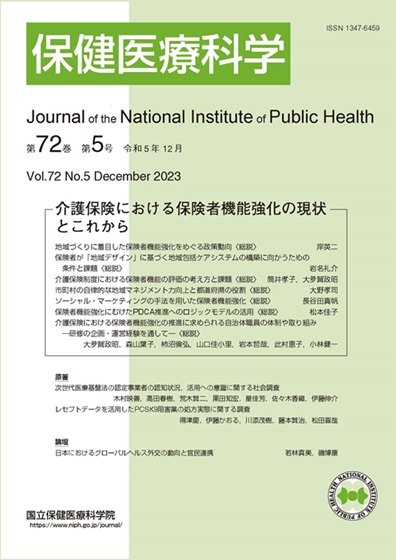Volume 72, Issue 5
Currrent status and prospects for strengthening management of long-term care insurance
Displaying 1-11 of 11 articles from this issue
- |<
- <
- 1
- >
- >|
Topics
-
Article type: Preface
2023Volume 72Issue 5 Pages 375
Published: December 28, 2023
Released on J-STAGE: February 15, 2024
Download PDF (1195K) -
Article type: Review
2023Volume 72Issue 5 Pages 376-
Published: December 28, 2023
Released on J-STAGE: February 15, 2024
Download PDF (2698K) -
Article type: Review
2023Volume 72Issue 5 Pages 387-394
Published: December 28, 2023
Released on J-STAGE: February 15, 2024
Download PDF (1335K) -
Article type: Review
2023Volume 72Issue 5 Pages 395-405
Published: December 28, 2023
Released on J-STAGE: February 15, 2024
Download PDF (2617K) -
Article type: Review
2023Volume 72Issue 5 Pages 410-421
Published: December 28, 2023
Released on J-STAGE: February 15, 2024
Download PDF (1867K) -
Article type: Review
2023Volume 72Issue 5 Pages 422-430
Published: December 28, 2023
Released on J-STAGE: February 15, 2024
Download PDF (1602K) -
Article type: Review
2023Volume 72Issue 5 Pages 431-433
Published: December 28, 2023
Released on J-STAGE: February 15, 2024
Download PDF (3715K) -
Article type: Review
2023Volume 72Issue 5 Pages 444-453
Published: December 28, 2023
Released on J-STAGE: February 15, 2024
Download PDF (1760K)
Articles
-
Article type: Review
2023Volume 72Issue 5 Pages 454-463
Published: December 28, 2023
Released on J-STAGE: February 15, 2024
Download PDF (1505K) -
Article type: Original
2023Volume 72Issue 5 Pages 464-474
Published: December 28, 2023
Released on J-STAGE: February 15, 2024
Download PDF (1351K) -
Article type: Commentary
2023Volume 72Issue 5 Pages 475-482
Published: December 28, 2023
Released on J-STAGE: February 15, 2024
Download PDF (1537K)
- |<
- <
- 1
- >
- >|
